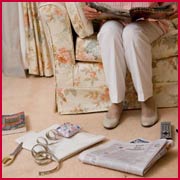Healthy active ageing: Make sure your home is safe
Creating a safe environment in and around your home will help you manage your lifestyle as you get older. This section provides tips on keeping the inside and outside of your home safe by identifying, removing or modifying any hazards.
Home maintenance and keeping your yards safe are important in preventing falls. For more information or to assess your individual situation, download our comprehensive How to Stay On Your Feet® Checklist.
| Things to think about | Potential hazards | Tips for keeping safe |
 Your bedroom | More than 60% of falls happen in the bedroom. The main hazards are getting in and out of bed, insufficient lighting and tripping over cords, bedspreads, pets or clutter on the floor. | Make getting in and out of bed safer by having a bed with the right height and a firm mattress. Roll on your side then sit up before standing up. Wait for any dizziness to settle before standing. If you are getting up during the night (eg. to go to the toilet), try and have a light switch or torch near your bed and give yourself some time to adjust to the light. |
 Your bathroom and toilet | The bathroom can present a slipping hazard. | Use non-slip flooring and non-slip mats in the shower and bath. If you need additional support, install grab rails beside the toilet and in the bath and shower. Have all toiletries within easy reach and use a shower caddy. If possible, have a hob-less shower recess that you don't need to step over. Keep floors dry. |
 Your kitchen | Spills, the need to reach, and the need to carry items can present hazards in the kitchen. | Identify, remove or modify hazards by making your work areas more convenient for reaching. Make sure the kitchen is well lit. Use a mobile tray to carry items if needed. |
 Your lounge/living room | The main hazards are getting in and out of chairs or tripping over clutter. | Make sure your chair has armrests, is not too low and is easy to get in or out of. Make sure you have what you need within easy reach. Use a cordless phone. Avoid clutter on the floor such as electrical cords. Try and maintain clear pathways for high traffic areas. |
  Your floors, walkways and stairs | Stairs and steps are common problem areas. It is also important to keep floors and walkways clear to avoid tripping. | Make sure the area is well lit by using 75 watt light bulbs. Make sure stairs have adequate hand rails. You can mark the edges of your stairs to make them more visible. Make sure floor coverings are not slippery and rugs don't curl at the edges. |
 Outside your home | Areas outside the home can become slippery, especially when wet. | Make sure areas outside the home are well lit, and have properly maintained surfaces. Remove leaf litter and store your garden equipment safely. In public places, look out for trip and slip hazards. If you see a hazard like a cracked footpath, contact your local council. |
 When doing home maintenance | Many falls result from trying to do jobs that are too hard to reach. If you have odd jobs that need doing, make sure you have the right equipment and consider asking someone to help or do the job with you. | Avoid using ladders, and if you need to, make sure your ladder is safe and someone is with you. |
Hazards in the home: Useful links
- Better Health Channel – provides tips on how to reduce the risk of falls in the home and yard.
